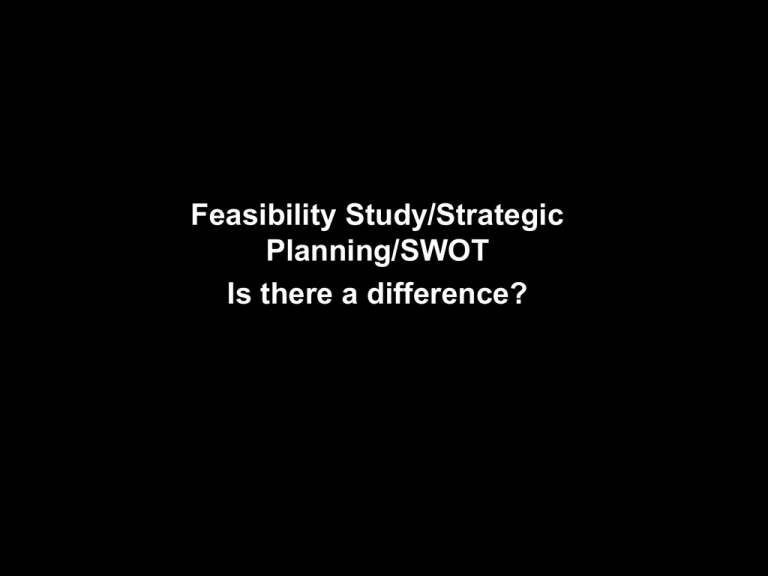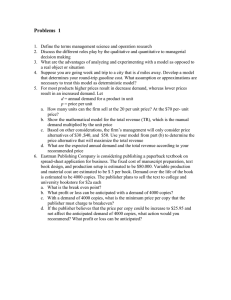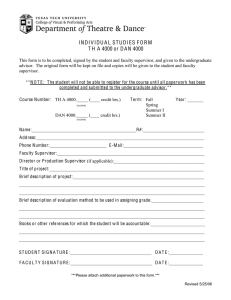Download planning.ppt
advertisement

Feasibility Study/Strategic Planning/SWOT Is there a difference? What is a Feasibility study? A study that is provides focus on the primary issues of a business idea. The process takes a subjective look at any “make or break” issues that would prevent a business from being successful. Feasibility Study? This analysis provides necessary information that is used as the basis for a business plan. Is the project feasible? What flaws or barriers would lead to failure? This information provides the basis for the marketing analysis and strategy of the business plan. SWOT, what is it good for? . Strengths Weaknesses Opportunities Threats • • • • • Possible Strengths: Finance expertise. Innovation Proximity to raw materials Superior equipment And various other competitive advantages. • • • • • Possible Weaknesses: No finance expertise Commodity product in a mature Remote or poor access location Broken down and obsolete machinery damaged reputation • • • • • Possible Opportunities: High potential market – the internet or evolving country. Creating strategic alliances Transition into new markets Global market An unfulfilled niche in a a market segment Possible Threats: • Entry of competitors into the market • Price wars • Breakthrough in alternative or competing product • Language and cultural barriers • Legal constraints or new taxes for your product A word of caution, SWOT analysis is not a science with definitive resolve and issues. Subjective analysis can be dangerous as two individuals can differ on the version of SWOT. It is supposed to draw discussion on the positive and negative issues facing an organization. The final answers are not necessarily correct. Important Considerations • Keep the issues realistic. Take an honest look in the mirror. • Think strategically. Where are we and where do we want to go. • Don’t get bogged down with short-term issues. • Keep discussions focused and on target. • Find benchmarks or and competitive analysis to draw on SWOT issues. Where are you better or worse than your competitors. • Keep the analysis concise and basic. Do not over analyze the issues. All participant need to understand the issues. Financial and Business Planning 80% / 50%/ 30% Failure? Lack of Planning Lack of Experience Insufficient Capital What is a Business Plan? Conceptual – Collection of ideas and actions anticipated over the long term to ensure the economic success of the business. Physical – A document detailing the collection of ideas and actions to be taken. The document should include a detailed description of the business, the market, marketing strategies, management and organizational, and financial parameters. 8 Reasons to Write A Business Plan 1) 2) 3) Build a case for funding of a start-up or expansion of an existing business. Identify and define goals, management, and operational strategies of a new or established business. Document the feasibility of starting a business or expanding. 4) Serves as a measure of performance and indicates a need for changes. 5) Enables a business to focus efforts to achieve key objectives. 6) Defines where a company is going and how to get there. 7) Determines the financial resources required 8) Gives you an objective, critical, and unemotional look at your business project in its entirety. CONTENTS Executive Summary Statement of Purpose Description of the Business Competition CONTENTS Market Strategy Location Management Personnel Uses of Funds Appendices Appendices Cash Flow Statement Balance Sheet Personal & Business Tax Returns 3 years Personal Financial Statement Resume Equipment Lists List of Collateral BUSINESS NAME:STARTUP RESTAURANT ADDRESS:_________________________ _________________________ May-02 BEGINNING CASH 126100 BANK LOAN, Note 1 180000 -REAL ESTATE ACQUISITION 250000 -REMODELING 14000 -EQUIPMENT, FIXTURES 8800 -ADVERTISING 1500 -INVENTORY&LICENSES 1800 -CLOSING COSTS 20000 CASH -ON -H AN D 10000 CONTACT PERSON: JOE ENTREPRENEUR TELEPHONE #: PROJECTION BEGINS: MAY,2002 Jun-02 8069 Jul-02 9058 Aug-02 10767 Sep-02 13196 Oct-02 16345 Nov-02 20214 Dec-02 25083 Jan-03 33552 Feb-03 38421 Mar-03 43290 Apr-03 48159 8069 9058 10767 13196 16345 20214 25083 33552 38421 43290 48159 REVENUES 20000 21000 22000 23000 24000 25000 25000 30000 25000 25000 25000 25000 BEGINNING INV +PURCHASES, Note 3 -ENDING INV COST OF GOODS 4000 5800 4000 5800 14200 4000 5880 4000 5880 15120 4000 6160 4000 6160 15840 4000 6440 4000 6440 16560 4000 6720 4000 6720 17280 4000 7000 4000 7000 18000 4000 7000 4000 7000 18000 4000 8400 4000 8400 21600 4000 7000 4000 7000 18000 4000 7000 4000 7000 18000 4000 7000 4000 7000 18000 4000 7000 4000 7000 18000 2000 4100 2500 110 1000 200 200 2000 150 175 300 12,735 2000 4100 2500 110 1000 200 200 2000 150 175 300 12,735 2000 4100 2500 110 1000 200 200 2000 150 175 300 12,735 2000 4100 2500 110 0 200 200 2000 150 175 300 11,735 2000 4100 2500 110 0 200 200 2000 150 175 300 11,735 2000 4100 2500 110 0 200 200 2000 150 175 300 11,735 2000 4100 2500 110 0 200 200 2000 150 175 300 11,735 2000 4100 2500 110 0 200 200 2000 150 175 300 11,735 2000 4100 2500 110 0 200 200 2000 150 175 300 11,735 1396 1,396 1396 1,396 1396 1,396 1396 1,396 1396 1,396 1396 1,396 1396 1,396 1396 1,396 1396 1,396 1396 1,396 989 1,709 2,429 3,149 3,869 4,869 8,469 4,869 4,869 4,869 4,869 9,058 10,767 13,196 16,345 20,214 25,083 33,552 38,421 43,290 48,159 53,028 GR OS S P R OFIT SELLIN G, GEN ER AL & AD MIN IST R AT IVE EXPEN SES OWNER'S SALARIES 2000 2000 2000 EMPLOYEE WAGES 4100 4100 4100 UTILITIES 2500 2500 2500 TELEPHONE 110 110 110 INSURANCE 3000 1000 1000 MISC SUPPLIES 200 200 200 PROFESSIONAL FEES 200 200 200 TAXES 2000 2000 2000 ADVERTISING 150 150 150 CREDIT CARD FEES 175 175 175 MISC EXP 300 300 300 T OT AL SGA EXP 14,735 12,735 12,735 NEW LOAN AMORTIZATION BANK LOAN, Note 1 N EW LOAN T OT AL N ET PR OFIT (LOSS) CASH POSIT ION 1396 1,396 (1,931) 8,069 1396 1,396 WWW.BPLANS.COM WWW.BUSINESSPLANS.ORG Business Structures Sole Proprietorship Partnership Limited Liability Company Corporations Sole Proprietorship ‘doing business as’ (d/b/a) SIMPLE/ MINIMAL COSTS Suited to the start-up of a one-person business. However, the single owner assumes all business responsibilities, including unlimited financial liability incurred by the business. Partnership A relationship between two or more persons or companies doing business together Limited Liability Company Built for the small business LLC is an unincorporated business organization having liability for the contractual obligations and other liabilities of the business. File Articles of Organization with the NYS Department of State Corporations A NY State Corporation is an entity separate and distinct from the individual(s) who own and manage the business. Business corporations are operated for profit and are authorized to raise capital by selling shares of interest in the corporation. A corporation’s debts and obligations are distinctly it’s own. Commercial Lending Process 5 C’s of credit Character Capability Capital Conditions Collateral Character Clients willingness and determination to meet loan obligations Bankers are looking for individuals who will make every effort to repay a loan and will work openly and cooperatively with their banker if their business if experiences financial difficulties Credit Reporting Capacity/ Cash Flow Management’s ability to generate enough cash to satisfy all obligations. It is easier to evaluate the capacity of an established company. A banker looks at past financial performance and compares to other businesses in the same industry. It is more difficult to evaluate the capacity of a new business. In this case, managerial experience and training are critical considerations. Cash Flow projections Capital Funds available to operate a business, of which there are two primary considerations: The amount of equity capital the owners have invested in the business and How effectively the total capital, including creditor capital, is employed Conditions (No Control) Are external variables, such as the state of the economy and the type of industry in which the client’s business is a part. Collateral A borrower may pledge collateral to offset weaknesses in the other Cs Collateral provides the bank a secondary source of repayment if the primary source of repayment if the primary source of repayment does not materialize



![Supplies Requests [Acct. Category 4000]](http://s2.studylib.net/store/data/011540799_1-d039a200c28288657dec316fa1506442-300x300.png)